Cock Up Your Beaver

Cock Up Your Beaver is a song and poem by Robert Burns, written in 1792.[1] It is written in Scottish dialect and the beaver refers to a gentleman's hat in an era when all high quality men's hats were made of felted beaver fur.
It was based on an older song, published as "Johnny, cock up thy Beaver". It is widely claimed that this is found in The Dancing Master, a collection of folk tunes published by John Playford of London in 1657.[2][3] However, this is disputed by Scottish music scholar John Glen who correctly[4] states it first appears in the 1686 edition of "The Dancing Master".[5]
It was originally published in 1792 in volume 4 of the Scots Musical Museum[2] and again in 1821 in a compilation by James Hogg, with four verses and musical notation of a tune.[6]
The original version was English, and ridiculed Scotsmen who settled in London after the accession of James VI to the throne of England,[7] possibly satirizing the costumes of highland chiefs entering the lowlands.[8]
The song, hand-written by Burns, is in the Scots Musical Museum.[2][3]
A piece entitled Carolan's Variations on the Scottish Air "Cock Up Your Beaver" is composition no. 204 in the oeuvre of Turlough O'Carolan.[9]
References
[edit]- ^ Iain Macdonald. "BBC - Robert Burns Works - Cock Up Your Beaver". Archived from the original on 2009-01-31. Retrieved 2009-08-24.
- ^ a b c Johnson, James (1792). Scots musical museum. Edinburgh: James Johnson. p. 319. Archived from the original on 2022-09-25. Retrieved 2014-01-26.
- ^ a b James Johnson; Robert Burns; Stephen Clarke; William Stenhouse; David Laing; Charles Kirkpatrick Sharpe (1853), The Scots Musical Museum: Consisting of upwards of six hundred songs, with proper basses for the pianoforte (Vol. 4), The Scots Musical Museum (New ed.), W. Blackwood and Sons, p. 301, archived from the original on 2022-09-25, retrieved 2021-12-22
- ^ https://playforddances.com/dances/johnny-cock-thy-beaver/
- ^ Glen, John (1900). Early Scottish melodies: including examples from mss. and early printed works, along with a number of comparative tunes, notes on former annotators, English and other claims, and biographical notices, etc. Edinburgh: J. & R. Glen. p. 160.
- ^ James Hogg (1821), The Jacobite relics of Scotland: being the songs, airs, and legends, of the adherents to the house of Stuart, vol. 2, W. Blackwood, pp. 127, 128, archived from the original on 2022-09-25, retrieved 2021-12-22
- ^ Robert Burns; Robert Chambers; William Wallace (1896), Robert Chambers; William Wallace (eds.), The life and works of Robert Burns, vol. 4, Longmans, Green, p. 342
- ^ Allan Cunningham (1825), The songs of Scotland, ancient and modern; with an intr. and notes, archived from the original on 2022-09-25, retrieved 2021-12-22
- ^ O'Sullivan, Donal: Carolan: The Life Times and Music of an Irish Harper, 1st of 2 volumes, page 277 (London: Routledge and Kegan Paul, 1958); new edition in 1 volume: Cork: Ossian Publications, 2001; ISBN 1-900428-76-8 (hardback), 1-900428-71-7 (paperback)
External links
[edit]- Digitised copy of score for Cock up your beaver in volume 4 of James Johnson's Scots Musical Museum, printed between 1792, from National Library of Scotland. JPEG, PDF, XML versions.
- Reading by Alan Cumming
- Wikisource
